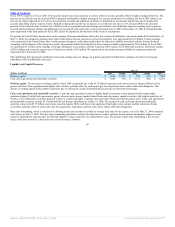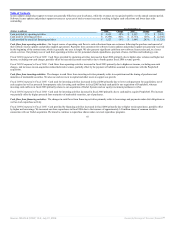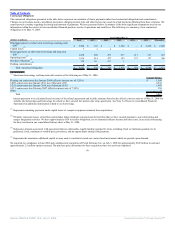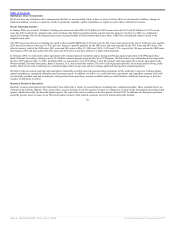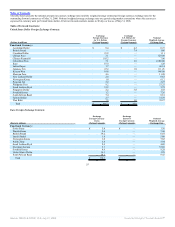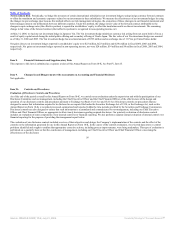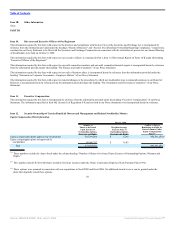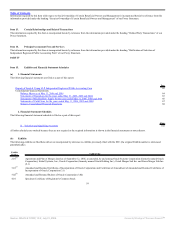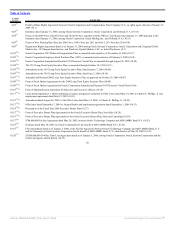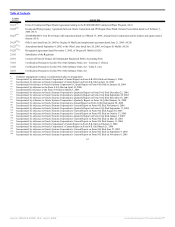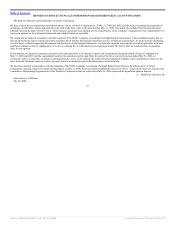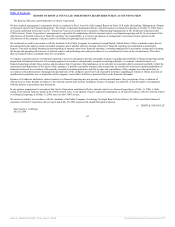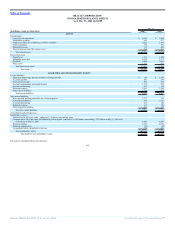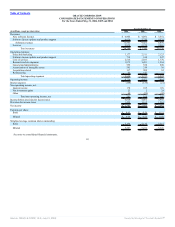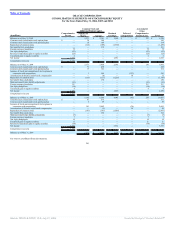Oracle 2005 Annual Report Download - page 59
Download and view the complete annual report
Please find page 59 of the 2005 Oracle annual report below. You can navigate through the pages in the report by either clicking on the pages listed below, or by using the keyword search tool below to find specific information within the annual report.
Table of Contents
Net Investment Risk. Periodically, we hedge the net assets of certain international subsidiaries (net investment hedges) using foreign currency forward contracts
to offset the translation and economic exposures related to our investments in these subsidiaries. We measure the effectiveness of net investment hedges by using
the changes in spot exchange rates because this method reflects our risk management strategies, the economics of those strategies in our financial statements and
better manages interest rate differentials between different countries. Under this method, the change in fair value of the forward contract attributable to the
changes in spot exchange rates (the effective portion) is reported in stockholders’ equity to offset the translation results on the net investments. The remaining
change in fair value of the forward contract (the ineffective portion) is recognized in non-operating income, net.
At May 31, 2006, we had one net investment hedge in Japanese Yen. The Yen investment hedge minimizes currency risk arising from net assets held in Yen as a
result of equity capital raised during the initial public offering and secondary offering of Oracle Japan. The fair value of our Yen investment hedge was nominal
as of May 31, 2006 and 2005. The Yen investment hedge has a notional amount of $595 million and an exchange rate of 111 Yen per United States dollar.
Net gains (losses) on investment hedges reported in stockholders’ equity were $23 million, $(23) million and $(38) million in fiscal 2006, 2005 and 2004,
respectively. Net gains on investment hedges reported in non-operating income, net were $24 million, $14 million and $8 million in fiscal 2006, 2005 and 2004,
respectively.
Item 8. Financial Statements and Supplementary Data
The response to this item is submitted as a separate section of this Annual Report on Form 10-K. See Part IV, Item 15.
Item 9. Changes In and Disagreements with Accountants on Accounting and Financial Disclosure
Not applicable.
Item 9A. Controls and Procedures
Evaluation of Disclosure Controls and Procedures
As of the end of the period covered by this Annual Report on Form 10-K, we carried out an evaluation under the supervision and with the participation of our
Disclosure Committee and our management, including the Chief Executive Officer and the Chief Financial Officer, of the effectiveness of the design and
operation of our disclosure controls and procedures pursuant to Exchange Act Rules 13a-15(e) and 15d-15(e). Disclosure controls are procedures that are
designed to ensure that information required to be disclosed in our reports filed under the Securities Exchange Act of 1934, or the Exchange Act, such as this
Annual Report on Form 10-K, is recorded, processed, summarized and reported within the time periods specified by the Securities and Exchange Commission.
Disclosure controls are also designed to ensure that such information is accumulated and communicated to our management, including our Chief Executive
Officer and Chief Financial Officer, as appropriate to allow timely decisions regarding required disclosure. Our quarterly evaluation of disclosure controls
includes an evaluation of some components of our internal control over financial reporting. We also perform a separate annual evaluation of internal control over
financial reporting for the purpose of providing the management report below.
The evaluation of our disclosure controls included a review of their objectives and design, the Company’s implementation of the controls and the effect of the
controls on the information generated for use in this Annual Report on Form 10-K. In the course of the controls evaluation, we reviewed data errors or control
problems identified and sought to confirm that appropriate corrective actions, including process improvements, were being undertaken. This type of evaluation is
performed on a quarterly basis so that the conclusions of management, including our Chief Executive Officer and Chief Financial Officer, concerning the
effectiveness of the disclosure
56
Source: ORACLE CORP, 10-K, July 21, 2006 Powered by Morningstar® Document Research℠


